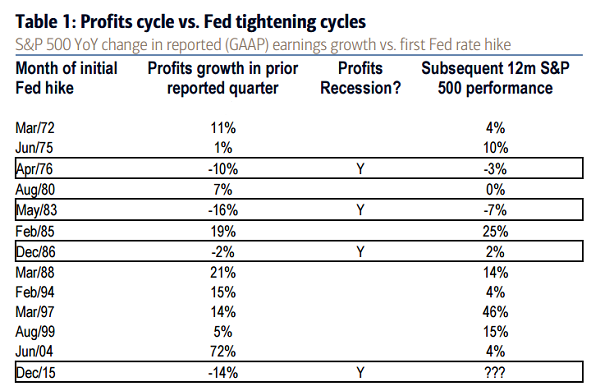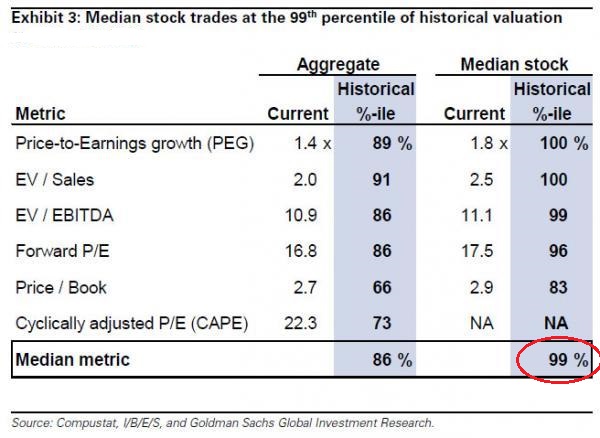Some charts are more interesting than others. For example, Rob Isbitts at Sungarden Investment Research pointed out that the three-year return for the S&P 500 has dipped below 30%. Why might that matter? When the three-year return disappointed investors with single-digit annualized gains (
Technical analysts have also taken notice of the “lower lows” in the S&P 500’s three-year return since the end of 2014. The pattern developed prior to the NASDAQ’s tech wreck in 2000. Lower lows for the three-year return also developed leading into the financial crisis in 2007.
The above-mentioned chart is intriguing. On the other hand, it hardly represents a death blow for stock enthusiasts.
What may be more troubling, however, is the history of corporate profit recessions and initial Federal Reserve rate hikes. According to Bank of America (NYSE:BAC), there have been three previous occasions when the Fed raised overnight lending rates at the same time that companies reported two consecutive quarters of earnings declines. The average result over the ensuing 12 months for the S&P 500? Negative returns.
The central bank of the United States bumped its rate higher by 0.25% in mid-December of 2015. The S&P 500 traded near 2075. If history holds, one might be hard-pressed to expect it to trade higher than 2075 in December of 2016.
Here’s something else. On those previous three occasions – April 1976, May 1983, December 1986 – the median stock did not trade anywhere near the 99th percentile of historical stock valuations. In other words, not only did the Fed hike overnight lending rates into an earnings recession in December of 2015, it raised them at a time when stocks were extremely overvalued. In fact, stocks have never been as overvalued as they are today on a price-to-sales (P/S) and price-to-earnings growth (PEG) basis.
Now here’s some bad news that may actually be good news for stocks. Approximately 664,000 working-aged individuals left the labor force in May, bringing the total of non-participants in the labor force to 94.7 million people. Job growth is averaging a mere 116,000 over the last three months – “gains” that are proceeding at HALF the pace required to keep up with the growth of the population. With numbers this bad, there’s virtually zero chance of a Fed move in June; odds for action in July are down to a mere 35%. In a nut shell, if the Fed is going to wait even longer before removing some of its stimulus, investors may interpret the inaction as an opportunity to add to their riskier asset holdings.
Me? I will not be adding to stock positions. I recognize that the slowdown for stocks has been in place for the better part of 18 months; indeed, the stock slowdown has been in effect since the Fed made its last asset purchase via quantitative easing (QE3) in mid-December of 2014. In fact, “risk off” assets like iShares 20-Plus Year Treasury (NYSE:TLT) have outpeformed “risk on” stock assets like Vanguard Total Stock Market (NYSE:VTI) and Vanguard FTSE All-World ex U.S. (NYSE:VEU) over the year-and-a-half period.
To be frank, it surprises me how few people seem to recognize the flatness of returns for U.S. stocks over 18 months. And for diversified investors? For those who incorporated a mix of “risk-on” assets across the spectrum like higher-yielding U.S. bonds and/or international stocks? The returns have been decidedly dismal for a very long time.
From my vantage point, it is difficult to see how things are going to get much easier in the near-term. Stock prices plummeted in the two most recent presidential cycles where the incumbent had not been seeking re-election (2000, 2008). What’s more, since 1928, stocks have logged an average of -2.8% in election years in which the incumbent is preparing to exit the Oval Office. In fact, the final year of an eight-year term is the only year that has produced a negative result.
There’s more. Researchers have found that companies tend to reduce capital expenditures by nearly 5% in election years relative to non-election years. If one couples a reduction in corporate willingness to spend on projects and human resources with existing concerns about business earnings, business sales, stock valuation, the global economic slowdown, as well as Federal Reserve rate policy, one might be wise to maintain a lower allocation to risk than might otherwise be typical.




